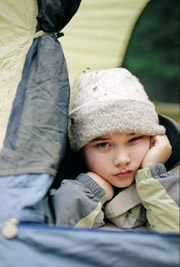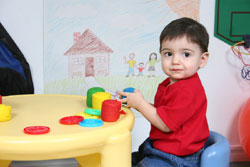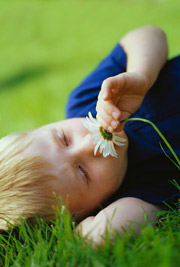- What is Autism
- Statistics on Autism
- Risk Factors for Autism
- Progression of Autism
- Symptoms of Autism
- Clinical Examination of Autism
- How is Autism Diagnosed?
- Prognosis of Autism
- How is Autism Treated?
- Autism References
What is Autism
Autism is a developmental disorder that affects the brain. It is a complex condition that mostly impairs communication, social interaction and creative play. People with autism often have problems forming relationships, and interacting with and responding to the world.
Signs of autism usually appear in the first three years of life and continue through adulthood. Autism belongs to a wide range of pervasive developmental disorders that include autism, autism spectrum disorders, Asperger’s syndrome, and other conditions with similar features. The effect of autism ranges from mild social impairment to severe disability.
Statistics on Autism
Autism affects about 5 children per 10,000 in Australia. However, there is a concern that autism is being underdiagnosed and that the real rate may be as high as 60 children per 10,000.
Males are affected 4 times more commonly than females.
Risk Factors for Autism
Autism is a very complex condition and its exact cause is unknown, although research is continuing. Genetics is believed to be the most important risk factor for autism, accounting for 90% of all cases of autism. However, the genetic component of autism is very complex, with multiple different genes involved. There is currently no genetic test available for autism.
Other predisposing factors include agents that cause birth defects such as thalidomide and valproic acid, although these are very rare causes. Other identified risk factors include:
- Increasing maternal or paternal age;
- Low birth weight;
- Prematurity.
In the past, there have been numerous other causes of autism suggested. However, there is no scientific basis to these claims. Autism is not caused by bad parenting, allergies, heavy metal poisoning or childhood vaccines. There is no evidence to link the measles-mumps-rubella (MMR) vaccine to autism.
Progression of Autism

Generally, autistic children with above average intellectual abilities show the most improvement over time. Some areas do not appear to change over time, especially repetitive behaviour (e.g. rocking or spinning a plate) and obsession with order and routine.
Autism is often associated with other medical conditions. The conditions that are more common are:
- Attention deficit hyperactivity disorder (ADHD);
- Depression in teenagers;
- Intellectual disability;
- Visual problems;
- Seizures (fits).
The rare conditions that are associated with autism include:
- Obsessive-compulsive disorder;
- Tourette’s syndrome;
- Fragile X syndrome;
- Bowel infections;
- Tuberous sclerosis.
One in four children with autism will develop seizures. These usually begin in early childhood, but can start as late as adolescence. The seizures are caused by abnormal electrical activity in the brain. There is usually a short period of unconsciousness, body shakes, unusual movements, or staring spells. Not everyone who has a seizure has epilepsy. Seizures can be treated by a variety of medications that can be discussed with your doctor.
Autism can place considerable stress on the family of the child. This can lead to significant psychological problems for the family, such as depression and relationship difficulties.
Symptoms of Autism
Autism will cause delays in a child’s development, especially in social skills, playing and the senses (hearing, sight, and taste).
First year of life
In the first year of life, it is difficult to recognise autism but there may be some signs. These are:
- Not interacting with others;
- No babbling or speech;
- No waving or other gestures;
- Avoiding eye contact;
- Preferring to be alone;
- Not liking attention (e.g. not liking cuddles).
Although these things do not mean the child is autistic, they are potential signs to discuss with your doctor if you are concerned.
Second year of life
Autism usually becomes apparent in the second year of life. An autistic child will likely have:
- Lack of interest in other children;
- Lack of eye contact;
- Delayed language development;
- Repetitive behaviours (e.g. rocking, lining up objects or flapping arms);
- Inappropriate reactions to people or objects (ignoring them or having temper tantrums).
Later childhood
Milder autism (and the autistic spectrum disorders) may present later in childhood with:
- Lack of interest in other children;
- Inappropriate reactions to other children (e.g. does not have the same emotion as other children, such as screaming when others are laughing);
- Loss of language;
- Focus on order and routine;
- Repetitive movements.
It is important to recognise autism as early as possible, as treatment is most effective if begun at an earlier age.
Clinical Examination of Autism

There are some warning signs that should prompt urgent investigation. These are:
- No babbling by 12 months;
- No gesturing (pointing, waving bye-bye) by 12 months;
- No single words by 16 months;
- No two-word spontaneous phrases by 24 months;
- Loss of any language or social skills at any age.
These children should be assessed with a specific diagnostic tool such as the Checklist for Autism in Toddlers (CHAT) or Childhood Autism Rating Scale (CARS).
How is Autism Diagnosed?
After initial screening, the child will need to be referred to a paediatrician and have several other tests done.
There are several tools that can be used to diagnose autism. In young children (1 – 3yrs old), these are the Checklist for Autism in Toddlers (CHAT), and Screening Tool for Autism in Two year olds (STAT). In older children, the most common tools are the Childhood Autism Rating Scale (CARS), the Autism Behaviour Checklist (ABC), and the Autism Diagnostic Interview Revised (ADI-R). These tests involve the doctor interviewing or playing with the child and then asking the parents questions about the child’s play, language, interaction with other children, and general development.
There are also other tests to rule out other causes of a child’s symptoms. The most important is a hearing test to exclude hearing impairment (which is a very common cause of language development delay) and an electroencephalogram to exclude any possible epilepsy. A speech pathologist will also need to assess the child for any specific speech disorder.
Treatment should be started as soon as possible after diagnosis.
Prognosis of Autism
A diagnosis of autism encompasses a large spectrum of different levels of disability. The outcome for a particular individual with autism will depend on the severity of their autism. Although there is no way to predict the future outcome of autism, there are indicators of how well a person will do.
Traditionally, of autistic children who develop language before the age of 6 and have a normal IQ:
- 20% will live a highly independent life with a job and some friends;
- 20% will have some independence, but live with considerable family support;
- 60% will need residential care with high level support.
While severe autism makes independent living very difficult, some autistic individuals have spectacular talents in particular areas (e.g. art or mathematics).
Recently, there have been improvements in both early diagnosis and treatment of autism. The outcomes for young children with autism seem more positive with these new early interventions.
How is Autism Treated?

For behavioural therapy to be most successful, it is suggested that about 35-40 hours of therapy should be given to children every week.
It is important to realise that while some interventions are backed up by good scientific evidence, no intervention will work for every child with autism, and individual results will always vary.
When to start therapy
Start therapy as soon as possible, taking time to customise the best therapy to the child. Studies have shown that early intervention allows the brain to fine tune sensory systems and increase the level of interconnection between different parts of the brain.
Goals of therapy
There are several targets of autism therapy. These include language improvements, motor development, play and communication improvements.
Therapy is usually provided by special centres with qualified staff, although parents must be involved for the therapy to succeed. Studies have shown that leads to improved child communication, increased maternal knowledge of autism, enhanced parent-child interaction, and a reduced rate of maternal depression.
Behavioural therapy
Applied behaviour therapy
The most common type of therapy is called applied behaviour therapy. This is tailored behavioural modification therapy based on an a 3 step process:
- A request is made of the child.
- The child responds with positive, negative or no response.
- The therapist reacts. Strong positive (praise or treat) or negative (“No!”) response.
This is applied to very simple tasks such as brushing teeth. Often visual aids or demonstrations are used to help the child. The result is an improvement in the child’s behaviour.
For example, if a child hits a pet dog, behavioural therapy will work toward changing this into petting the dog. If a child is asked a question and doesn’t respond, behavioural therapy will work to help the child interact in a conversation.
Although this therapy sounds simple, it requires 20-40 hours a week to work effectively. It should be performed by trained therapists to achieve the best results.
Social-pragmatic therapy
The social-pragmatic approach focuses on a child’s communication skills and relationship building. One such program is Floorspace, which focuses on building attachment between the child and the parent through play. The parent follows the child’s lead and joins with the child in their favourite play activity.
TEACCH therapy
The Treatment and Education of Autistic and related Communication-handicapped Children (TEACCH) program involves activity schedules in the teaching environment to increase organisation and predictability. It also includes individual work stations to promote independent problem-solving, using visual cues to successfully finish tasks.
Other therapies
Other programs include using visual aids for education, sensory integration therapy, computer therapy, music therapy, speech therapy and social skills training.
Pharmacological therapy
Drug treatment can also be useful in autism, especially in conjunction with behavioural therapy. Research shows that about half of autistic children are given medication by their doctors.
The most common medication is risperidone (Risperdal Oral), which can benefit by reducing irritability, repetitive behaviours and social withdrawal. A similar medication that is sometimes used is olanzapine (Zyprexa).
Other medications that can be used are anti-seizure medications, antidepressants, and stimulants. These types of drugs are used to a lesser extent.
There is limited scientific evidence on the effectiveness of drugs in the long term management of autism. Most medication is given to help parents with symptoms or to control comorbid conditions such as epilepsy.
Autism References
- Williams K, Glasson E, Wray J, et al. Incidence of autism spectrum disorders in children in two Australian states. Med J Aust. 2005;182(3):108-11. Abstract | Full text
- Newschaffer CJ, Croen LA, Daniels J, et al. The epidemiology of autism spectrum disorders. Annu Rev Public Health. 2007;28:235-58. Abstract
- Freitag CM. The genetics of autistic disorders and its clinical relevance: A review of the literature. Mol Psychiatry. 2007;12(1):2-22. Abstract
- Szpir M. Tracing the origins of autism: A spectrum of new studies. Environ Health Perspect. 2006;114(7):A412-8. Full text
- Kolevzon A, Gross R, Reichenberg A. Prenatal and perinatal risk factors for autism. Arch Pediatr Adolesc Med. 2007;161(4):326-33. Abstract | Full text
- Doja A, Roberts W. Immunizations and autism: A review of the literature. Can J Neurol Sci. 2006;33(4):341-6. Abstract | Full text
- Lainhart JE. Advances in autism neuroimaging research for the clinician and geneticist. Am J Med Genet C Semin Med Genet. 2006;142C(1):33-9. Abstract
- Howlin P. Autism spectrum disorders. Psychiatry. 2006;5(9):320-4. Abstract
- Seltzer M, Shattuck P, Abbeduto L, Greenburg J. Trajectory of development in adolescents and adults with autism. Ment Retard Dev Disabil Res Rev. 2004;10(4):234-47. Abstract
- Zafeiriou DI, Ververi A, Vargiami E. Childhood autism and associated comorbidities. Brain Dev. 2007;29(5):257-72. Abstract
- Tuchman R, Rapin I. Epilepsy in autism. Lancet Neurol. 2002;1(6):352-8. Abstract
- Howlin P, Goode S, Hutton J, Rutter M. Adult outcome for children with autism. J Child Psychol Psychiatry. 2004;45(2):212-29. Abstract
- Dover CJ, Couteur AL. How to diagnose autism. Arch Dis Child. 2007;92(6):540-5. Abstract | Full text
- Matson JL. Current status of differential diagnosis for children with autism spectrum disorders. Res Dev Disabil. 2007;28(2):109-18. Abstract
- Cass H, Sekaran D, Baird G. Medical investigation of children with autistic spectrum disorders. Child Care Health Dev. 2006;32(5):521-33. Abstract
- McConachie H, Diggle T. Parent implemented early intervention for young children with autism spectrum disorder: A systematic review. J Eval Clin Pract. 2007;13(1):120-9. Abstract | Full text
- Landa R. Early communication development and intervention for children with autism. Ment Retard Dev Disabil Res Rev. 2007;13(1):16-25. Abstract
- Rao PA, Beidel DC, Murray MJ. Social skills interventions for children with Asperger’s syndrome or high-functioning autism: A review and recommendations. J Autism Dev Disord. 2008;38(2):353-61. Abstract
- Bellack AS. Skills training for people with severe mental illness. Psychiatr Rehabil J. 2004;27(4):375-91. Abstract
- Oswald DP, Sonenklar NA. Medication use among children with autism spectrum disorders. J Child Adolesc Psychopharmacol. 2007;17(3):348-55. Abstract
- Jesner OS, Aref-Adib M, Coren E. Risperidone for autism spectrum disorder. Cochrane Database Syst Rev. 2007;(1):CD005040. Abstract | Full text
All content and media on the HealthEngine Blog is created and published online for informational purposes only. It is not intended to be a substitute for professional medical advice and should not be relied on as health or personal advice. Always seek the guidance of your doctor or other qualified health professional with any questions you may have regarding your health or a medical condition. Never disregard the advice of a medical professional, or delay in seeking it because of something you have read on this Website. If you think you may have a medical emergency, call your doctor, go to the nearest hospital emergency department, or call the emergency services immediately.








